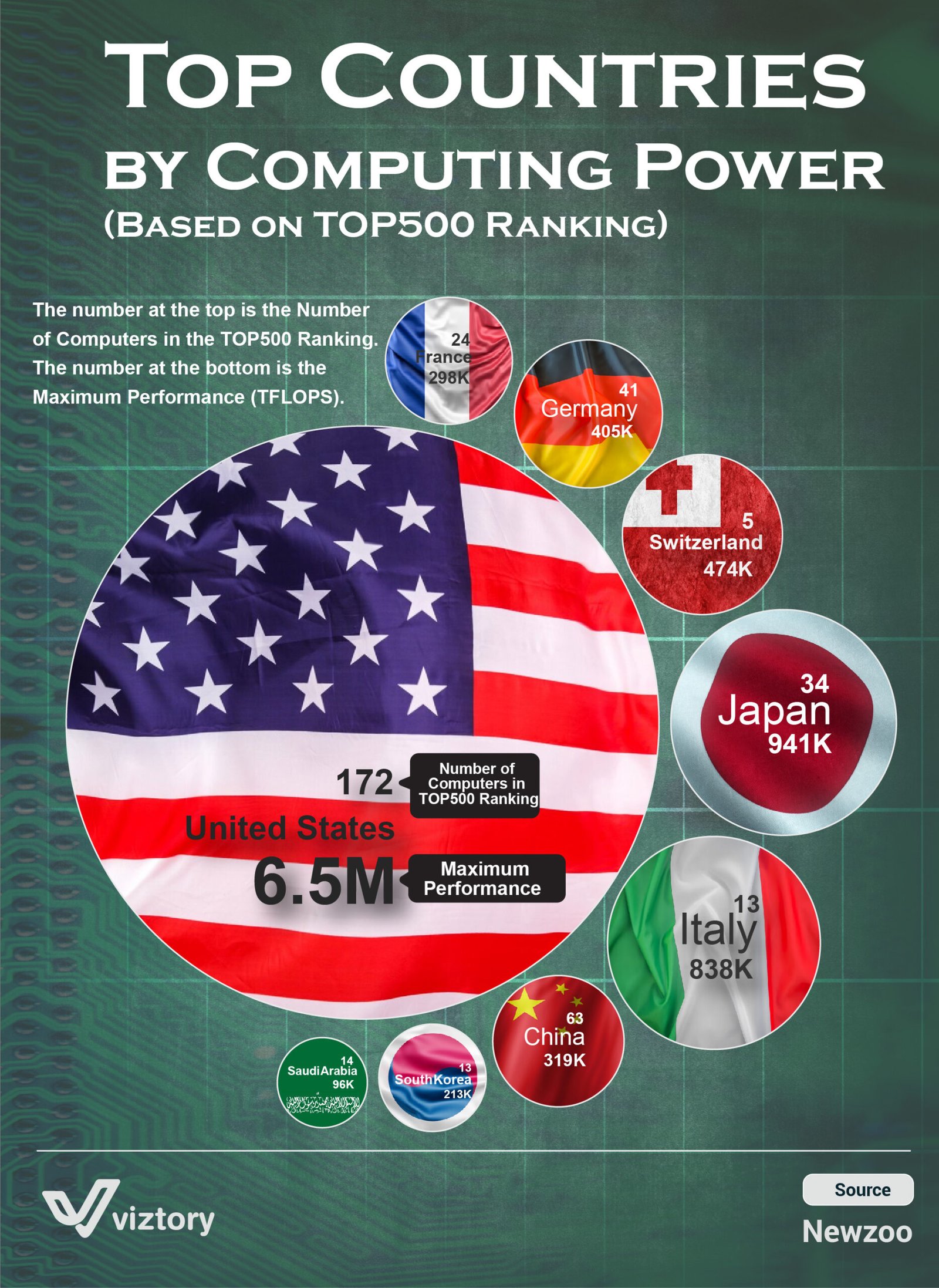Top Countries by Computing Power (Based on TOP500 Ranking)
-
Jan, Sat, 2025
In the era of rapid technological advancements, computing power has emerged as a cornerstone of progress. The chart illustrates the global distribution of high-performance computing (HPC) systems ranked in the TOP500, shedding light on the countries leading in computational capacity and innovation. These systems are critical for breakthroughs in artificial intelligence, weather modeling, pharmaceutical research, and many other fields.
The United States: Dominating the HPC Landscape
Leading the world, the United States boasts 172 supercomputers in the TOP500 ranking, with an unparalleled maximum performance of 6.5 million TFLOPS (teraflops). This dominance is a testament to the U.S.’s commitment to innovation and its ability to integrate cutting-edge technology into various sectors, from national defense to scientific research. The presence of industry leaders like NVIDIA, Intel, and IBM further solidifies its position at the forefront of high-performance computing.
Japan: A High-Performance Powerhouse
Japan follows with a significant computing performance of 941,000 TFLOPS across 34 systems. The nation’s investment in supercomputing is exemplified by systems like Fugaku, which has been pivotal in advancing research in areas such as drug discovery, disaster simulation, and material science. Japan’s focus on efficiency and sustainability sets a benchmark for HPC development globally.
Europe: A Collaborative Hub of Innovation
European nations like Germany, Switzerland, and Italy demonstrate their technological capabilities, with maximum performances of 405,000, 474,000, and 838,000 TFLOPS, respectively. Germany leads Europe with 41 systems, emphasizing its leadership in industrial applications of HPC. Switzerland and Italy also play a crucial role, leveraging their systems for scientific and engineering advancements, including climate research and advanced manufacturing.
China: A Growing Contender
China ranks second in the number of systems, with 63 supercomputers contributing a combined performance of 319,000 TFLOPS. While its maximum performance trails behind the U.S., China’s focus on indigenous development of HPC hardware and software positions it as a rising supercomputing power, critical to its broader technological ambitions.
Emerging Players in HPC
South Korea, Saudi Arabia, and smaller contributors are steadily growing their presence in the HPC domain. South Korea’s performance of 213,000 TFLOPS and Saudi Arabia’s 96,000 TFLOPS highlight their increasing investments in technology-driven research and development, particularly in areas like energy exploration and artificial intelligence.
The Impact of High-Performance Computing
High-performance computing is more than a race for numbers; it is a driver of transformative innovation. From decoding complex genomes to modeling climate change and powering artificial intelligence, these systems are at the heart of modern scientific and industrial progress. Countries investing in HPC infrastructure are not only advancing their technological capabilities but also strengthening their positions in the global innovation economy.
Conclusion
The chart underscores the critical role of computing power in shaping the future. Nations leading in this field are not only pushing the boundaries of what is possible but are also setting the stage for global competitiveness in the 21st century. As HPC systems continue to evolve, their influence on science, technology, and society will only grow, making computing power a cornerstone of modern advancement.

